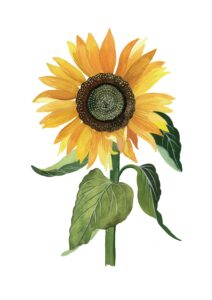 Sunflowers and Plath’s Liberal Arts Adviser
Sunflowers and Plath’s Liberal Arts Adviser
By Sunshine Schneider (’23)
Kenneth Wright, a botany professor at Smith College from 1946 to 1967, taught Sylvia Plath’s first year General Botany course (Botany 11). He also served as her liberal arts adviser prior to Plath declaring English as her major. Based on evidence from many of her letters, it is clear that she looked up to and respected Wright, as she called him “a darling,” believed that his class would prove to be fun and interesting, and expressed joy and pride at the prospect of Wright recognizing her out of all of his students (see Plath 2017: 175-189). His research and writing shed light on how he may have influenced Plath’s writing and thinking.
Wright was a plant physiologist, and during Plath’s time at Smith College he explored the effects of radiation on plants’ ability to absorb and distribute water and soil nutrients. Working with a Fellow in the Botany Department named Nancy Barton, he and Barton used the Mammoth Russian cultivar of sunflowers, which he exposed to a culture solution containing P-32, a radioactive isotope of phosphorus (see Wright and Barton 1955). They then put sunflowers in environments that would result in different rates of transpiration (i.e., the release of moisture from pores in the leaf) for 90 minutes, observing the movement of P-32 through the plants at the end of the experiment. They found that plants with a higher transpiration rate had more P-32 in the upper leaves, while the plants with a lower transpiration rate had more P-32 in its lower leaves. The research might have been prompted by concerns about nuclear fallout during the Cold War, concerns that were very much also on Plath’s mind at that time (e.g., see Clark 2020: 140, 158).
Another of Kenneth Wright’s works published just before Plath arrived is entitled “The Teleological Approach in Botany” (Wright 1948). In this paper he observes that many people, even those in the scientific community, tend to personify plants and incorrectly ascribe meaning or an explanation to their traits. He gives an example in the statement, “flowers are colored to attract insects” as opposed to “colored flowers attract insects” (Wright 1948: 187). While the latter is simply a statement of fact which does not ascribe any intent to the plant, the former implies an action taken with planning and intent, something that plants are not really capable of.
This approach to explaining plant traits is teleological, he explains, meaning that it relies on assumptions about the purpose served by these traits as opposed to describing what they do. He counters the idea that plants have colorful flowers to attract insects with the fact that many colorful plants don’t utilize insects for pollination or produce fertile seeds in areas of the plant that may lack color. If flowers were, in fact, colored to attract insects, these plants would not have colorful flowers as there would be no need. This contradiction presents a flaw in the teleological approach to botany, and this emphasis on description rather than assumption may have been useful for the poet Plath.
The way people often talk about sunflowers, in fact, is emblematic of this teleological approach. Sunflowers are famous for turning west throughout the day and back east at night in order to face the sun (a trait known as heliotropism) but this is not entirely true. Firstly, only young flowers exhibit this behavior and mature sunflowers stay facing the same direction, usually east. Secondly, the statement “sunflowers turn during the day to face the sun” is teleological, as it ascribes an intent to this characteristic. All that is known from observing heliotropism is that young sunflowers reorient themselves, from east to west during the day, and back east at night. One would then need to investigate further to know the mechanisms and reasons why.
A 2016 study found that heliotropism in sunflowers can be explained by circadian rhythms (Atamanian et al. 2016). The authors found that movement in the heads of the flowers is caused by differing rates of growth on opposite sides of the stem at different times. During the day, the east side of the stem grows faster than the west, causing the flower to turn west. Conversely, at night, the west side grows faster, turning the flower towards the east. While it is true that this results in them getting more sunlight, Wright would agree that his explanation is much more scientific and rigorous than the simple teleological approach of saying that sunflowers reorient themselves because they are trying to get more sunlight.
Even though most people do not think of botany when they think of Sylvia Plath, her botanical education was significant, and Kenneth Wright played a major part in it. Because Plath seemed to admire and look up to Wright, it is likely that he passed some of his ideals about botany and science in general down to her. Examining his botanical work and scientific perspectives can provide a deeper understanding of Plath’s works involving plants.
Works Cited
Atamian, Hagop S., Nicky M. Creux, Evan A. Brown, Austin G. Garner, Benjamin K. Blackman, and Stacey L. Harmer. 2016. “Circadian Regulation of Sunflower Heliotropism, Floral Orientation, and Pollinator Visits.” Science 353 (6299): 587–90.
Clark, Heather L. 2020. Red Comet: The Short Life and Blazing Art of Sylvia Plath. New York, NY: Vintage.
Plath, Sylvia. 2017. The Letters of Sylvia Plath Volume 1: 1940-1956. Edited by Peter K. Steinberg and Karen V. Kukil. New York, NY: Harper.
Wright, Kenneth E. 1948. “The Teleological Approach in Botany.” The American Biology Teacher 10 (7): 187–89.
Wright, Kenneth E., and Nancy L. Barton. 1955. “Transpiration and the Absorption and Distribution of Radioactive Phosphorus in Plants.” Plant Physiology 30 (4): 386–88.